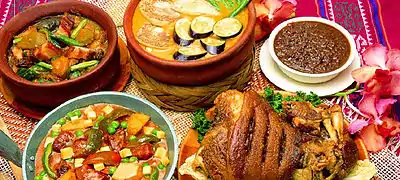| Type | Palm liquor |
|---|---|
| Country of origin | Philippines |
| Region of origin | Eastern Mindanao, Visayas, Bicol |
| Alcohol by volume | 35–50% |
| Ingredients | Nipa palm sap |
Laksoy (also spelled lacsoy), is a traditional Filipino distilled nipa palm liquor. It is derived from tubâ (palm toddy) made from nipa palm sap that has been aged for at least 48 hours. It originates from Eastern Mindanao, the Visayas Islands (where it is known as dalisay or dalisay de nipa), and the Bicol Region (where it is known as barik). During the Spanish colonial period, it was also known as vino de nipa in Spanish. Like the lambanog (made from coconut sap), it is particularly potent, having a typical alcohol content of 70 to 100 proof (40 to 45% abv) after a single distillation.[1]
History
Tubâ, a kind of palm wine, existed in the Philippines before colonisation. They were widely consumed for recreation and played an important role in various religious rituals. Heavy consumption of alcohol in the Philippine islands was described in several Spanish accounts. Social drinking (tagayan or inuman in Tagalog and Visayan languages) was and continues to be an important aspect of Filipino social interactions.[2][3][4]
Laksoy is pre-colonial in origin. Despite being distilled, laksoy and lambanog were inaccurately called vino de nipa and vino de coco, respectively, in Spanish. In Historia de Las Islas E Indios de Bisayas (1668), the Spanish missionary Francisco Ignacio Alcina described "dalisay" as vino de la nipa, el primero que se extrae y más fuerte ("nipa wine, the first to be extracted and the strongest").[5] In the Vocabulario de la lengua Tagala, primera, y segunda parte (1794) by Domingo de los Santos, he defines dalisay as a type of alac that is muy fuerte y bueno ("very stong and good").[6]
In Historia general sacro-profana, política y natural de las islas del poniente, llamadas Filipinas (1697-1755) by Juan José Delgado, native liquor is described as being distinguished into three types: vino ordinario (from the first distillate), dalisay (from the second distillate), and mistela (from the third distillate). In contrast to Alcina and other authors, Delgado applies the terms to both nipa and coconut liquor, distinguishing them as dalisay de nipa and dalisay de coco.[7][8]
Description
Tubâ has two main variants. The most common being the one made from coconut sap. This is distilled into lambanog. The second most common type of tubâ is made from nipa palm sap, which is where laksoy is derived from.[9] Like the lambanog (made from coconut sap), it is particularly potent, having a typical alcohol content of 70 to 100 proof (40 to 45% abv) after a single distillation.[1]
Production
Laksoy is more difficult to produce than lambanog because it requires the nipa palm to be covered in mud for six weeks to several months in advance. The mud is scraped off and the inflorescence is cut off. The sap that flows out of the cut branch is then collected in attached bamboo containers (salhod or salod). The bamboo containers are collected every day and the inflorescence is sliced again by a few millimeters to renew the flow of the sap. The sweet sap is fermented in banga (earthen jars) to make tubâ, which is then distilled into laksoy.[10][11]
See also
References
- 1 2 Mantiquilla, Junaldo A. (2013). "The Flowering Habit of Nipa (Nypa fruticans Wurmb.) in Semi-wild Stands of Davao Region, Philippines". Banwa. 10 (1): 16–32.
- ↑ Gibbs, H.D.; Holmes, W.C. (1912). "The Alcohol Industry of the Philippine Islands Part II: Distilled Liquors; their Consumption and Manufacture". The Philippine Journal of Science: Section A. 7: 19–46.
- ↑ Lasco, Gideon. "Tagay: Why there's no Tagalog word for "cheers" and other notes on Filipino drinking culture". Health, Culture, and Society in the Philippines. Retrieved May 6, 2019.
- ↑ Garcia, Lawrence (December 9, 2017). "Tagay: A Look at Philippine Drinking Culture". Humaling. Retrieved May 6, 2019.
- ↑ Alcina, Francisco Ignacio; Martín-Merás, María Luisa (1975). Historia de las islas e indios visayas del Padre Alcina, 1668. Editorial CSIC - CSIC Press. ISBN 9788450010541.
- ↑ de los Santos, Domingo (1794). Vocabulario de la lengua Tagala, primera, y segunda parte ... En la primera, se pone primero el Castellano, y despues el Tagalo y en la segunda al contrario ... compuesto por D. de los Santos. p. 831.
- ↑ Delgado, Juan José (1892). Biblioteca Histórica Filipina: Historia general sacro-profana, política y natural de las islas del poniente, llamadas Filipinas. p. 664.
- ↑ Alegre, Edilberto N. (1992). Inumang Pinoy. Anvil. p. 23. ISBN 9789712702310.
- ↑ Fernandez, Doreen G. (2019). Tikim: Essays on Philippine Food and Culture. BRILL. p. 17. ISBN 9789004414792.
- ↑ Mancall-Bitel, Nicholas (September 14, 2017). "15 Asian Spirits to Know Beyond Soju and Japanese Whisky". thrillist. Retrieved August 16, 2022.
- ↑ "11 Local Flavors of Wine in Philippines". FoodFindsAsia. Retrieved August 16, 2022.
